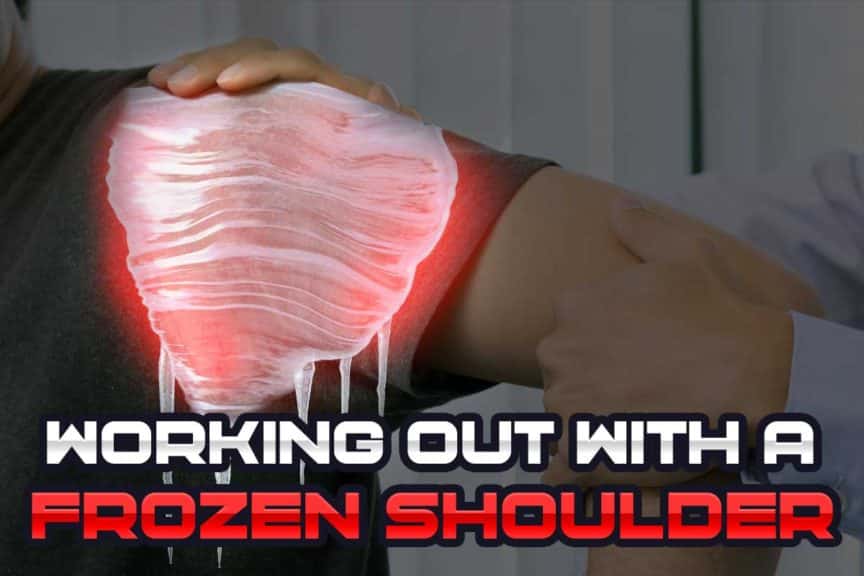A frozen shoulder can wreak havoc on your ability to exercise and train (and I would know!). Whether your shoulder is more limited by pain than immobility, or vice versa, finding ways to stay active while working to overcome the issue should be at the top of your priority list.
This article aims to provide insight that will hopefully help point you in the right direction for knowing how to exercise and workout while dealing with this frustrating issue.
Since the frozen shoulder experience can be highly variable from one individual to the next, exercising and working out should be finely tuned to the needs of each person. Pain, immobility and overall health will play a large role in selecting the most ideal exercises and movements.
While I can’t provide you with the exact needs for what your own shoulder requires, I can provide you with a high amount of general insight into the nature of this condition, the current scientific consensus for navigating it, and my own anecdotal experiences. There’s a lot to unpack here, but by the end of this article, you will hopefully feel much more well-armed for the battle of staying active and knowing how to appropriately workout with a frozen shoulder.
So, keep reading for all the details!
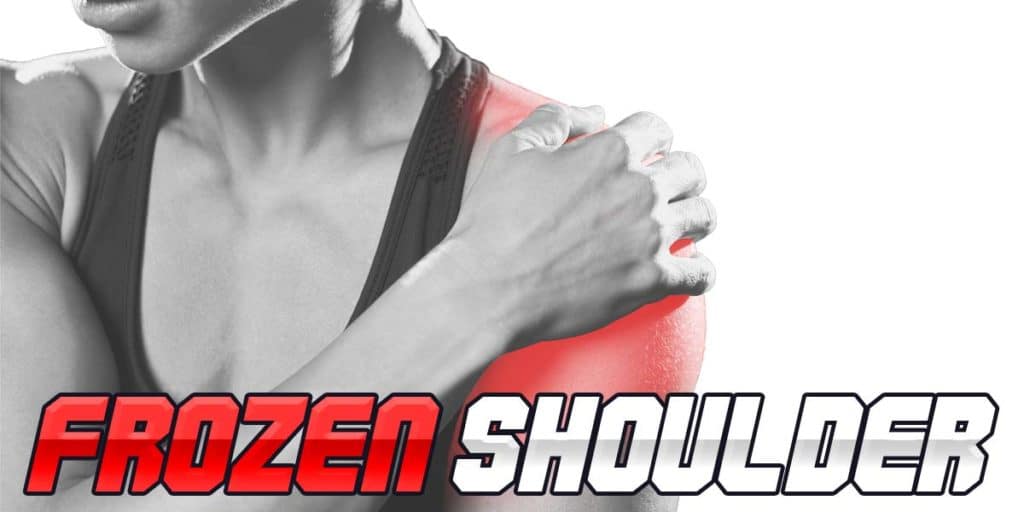
Related article: Here’s How to Fix Shoulder Pain From Dips (Complete Guide)
Disclaimer: While I am a physical therapist, I am not YOUR physical therapist. As a result, I cannot tell you whether or not any treatments or training methodologies mentioned on this website or in this article may or may not be appropriate for you, including exercising with a frozen shoulder. By following any information within this post, you are doing so at your own risk. You are advised to seek appropriate medical advice for any pain you may be experiencing.
Frozen Shoulder 101
If you want to take all the right steps for navigating how to stay active with a frozen shoulder and have the required confidence to do so along the way, you must understand the basics of the beast that you’re up against.
Having a basic understanding of what a frozen shoulder is, what exactly happens, and what the overall recovery process looks like is analogous to having a road map as you embark on your journey to recovery.
By understanding the basics of this condition, you’re much less likely to make costly mistakes, such as prolonging your recovery, undergoing unnecessary amounts of pain, or worsening the overall health of your shoulder.
In other words: Read this section and make sure you understand the basics of what’s happening with your shoulder!
What exactly happens with a frozen shoulder
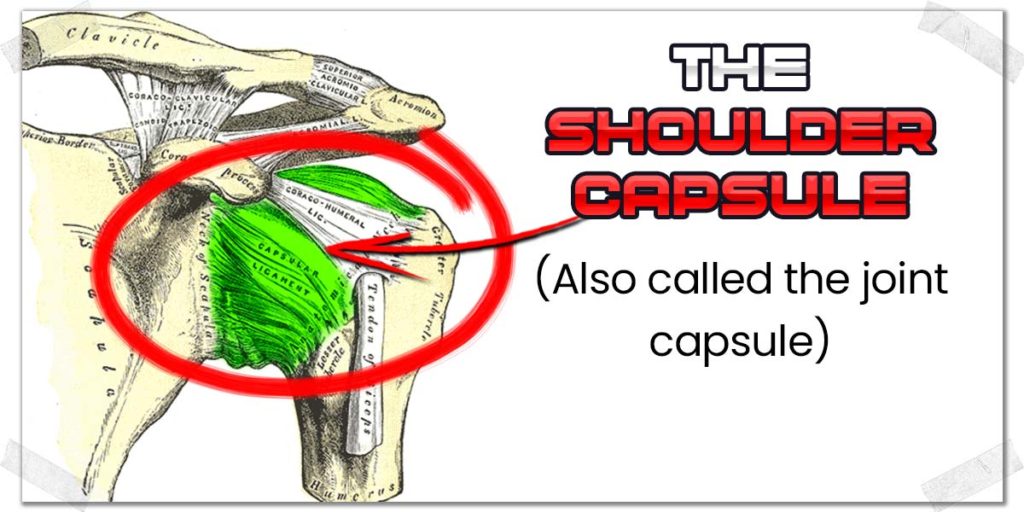
In its most basic sense, a frozen shoulder (officially known as adhesive capsulitis) is a spontaneous tightening of the shoulder capsule (the connective tissue that covers the ball and socket joint of the shoulder), which is most often accompanied by pain and a loss of available movement from the joint. It can happen after an injury to the shoulder or come on out of seemingly nowhere for no good reason.
While it’s a stubborn condition that can cause difficulty with shoulder movements and pain, the prognosis (expected long-term outcome) is usually quite favorable, with a high percentage of people gaining the vast majority (if not all) of their shoulder range of motion back within 12 – 18 months.1
A frozen shoulder typically goes through distinct phases from the time of onset to the resolution of symptoms (discussed below).
There are two types of frozen shoulder that can occur:
- Primary frozen shoulder: This type of frozen shoulder comes on out of nowhere for unknown reasons and is often termed “idiopathic frozen shoulder”. It’s not fully understood why this spontaneous stiffening of the capsule occurs.
- Secondary frozen shoulder: is the onset of a frozen shoulder following a traumatic injury to the shoulder. Due to a lack of movement from the injury, the shoulder capsule ceases up and a frozen shoulder results.
Stages of a frozen shoulder
A frozen shoulder generally has predictable stages that it will go through, with specific timelines or durations for each stage. Some experts and authors use a four-stage classification, while others use a three-stage classification.2 I’ll take a combined approach by giving you information on the four stages while placing the respective stages of the three-stage model in parenthesis. Here are the general stages, their characteristics and timelines:
Stage 1: (Initial onset)
In this stage, shoulder pain is often the greatest. Symptoms tend to last between 0-3 months, with pain being present for both active and passive movements.
Stage 2: (Freezing stage)
In this second stage of frozen shoulder, pain becomes chronic for both active and passive movements. It typically lasts between 2 – 9 months.
Stage 3: (Frozen stage)
This stage typically lasts between 4 – 12 months. It tends to be noticeably less painful than the previous two stages. Loss of range of motion is generally most notable in this stage, often with significant limitations.
Stage 4: (Thawing stage)
The final stage is the thawing stage, which can last between 12 – 24 months. In this stage, the shoulder spontaneously begins to recover with a gradual return to its normal range of motion. While many people recover their entire range, some studies show that 60% of those who are left with some residual loss of full range of motion.1
Who is most susceptible to getting a frozen shoulder?
While a frozen shoulder can happen to anyone (especially if it’s a secondary frozen shoulder), specific populations are more at risk for developing a primary frozen shoulder than others.
Overall, frozen shoulder affects around five percent of individuals. Women are four times more likely to be more affected than men. Interestingly enough, it also tends to affect one’s non-dominant shoulder more than their dominant shoulder.1,3 Ultimately, we don’t fully understand why this condition affects specific populations more than others; however, certain components can likely predispose these individuals to a frozen shoulder, which include:
- Hormonal components (such as thyroid levels)
- Comorbidities, such as type I & II diabetes
- Age (it’s most common around the fourth and fifth decade of life)
The classic frozen shoulder presentation
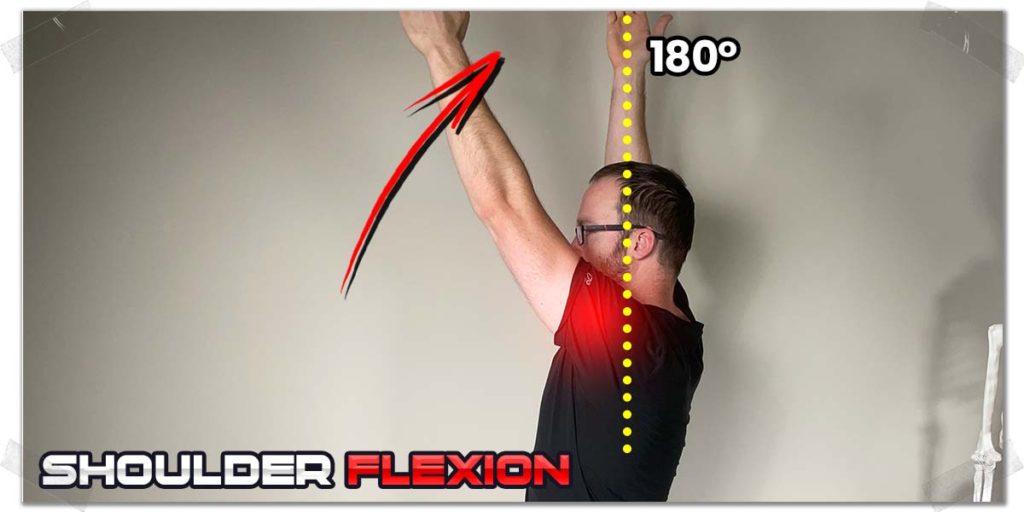
Diagnosing a frozen shoulder can be a tricky thing to do; there can be numerous issues and conditions that can lead to similar pain presentations and dysfunction of the shoulder. As a result, you must be certain (i.e., have been told by a qualified healthcare professional that you have a frozen shoulder) before implementing treatment strategies geared toward resolving the issue or before you attempt to workout or perform physical activities.
If you think you’re treating or working through a frozen shoulder when it’s, in fact, you have a different condition altogether, you could be doing more harm than good.
Typically, in addition to pain around the general shoulder region, a frozen shoulder will present with a loss of active range of motion (a movement you try to produce using your own muscles to do so) and with a passive range of motion (a movement that doesn’t require the use of your muscles, such as when someone moves your shoulder for you).
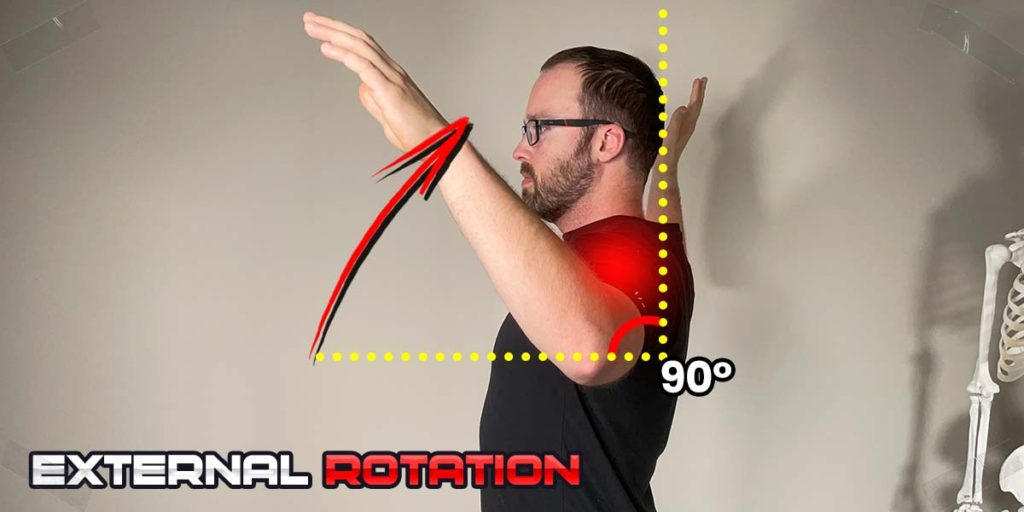
The two shoulder movements that are most commonly lost or reduced (either actively or passively) are:
- External rotation of the shoulder (rotating the arm outwards).
- Abduction of the shoulder (raising the shoulder out to the side of the body).
Other losses of specific shoulder movements can include:
- Shoulder flexion (raising your arm in front of you)
- Internal rotation (as if trying to place your arm behind your back)
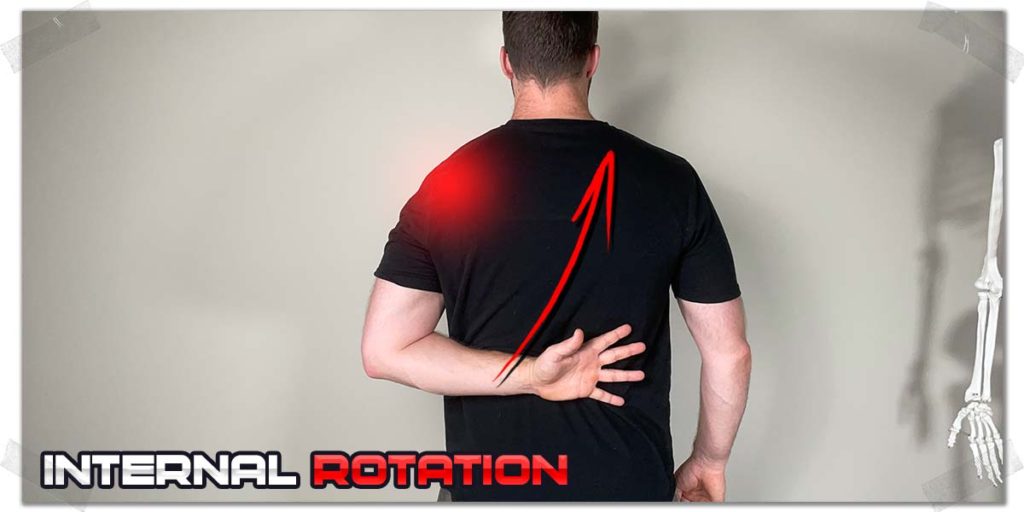
Pro tip: You will want to incorporate specific stretching and movement exercises for whichever ranges of motion are limited by the frozen shoulder. Getting these ranges of motion back should be a high priority in your recovery, and the recovery will likely happen to a quicker and more complete extent with routine stretching and therapeutic movements of your shoulder (covered later within this article).4
Pain vs immobility
One of the other unique mysteries of frozen shoulder is the different experiences with pain and immobility that affected individuals experience. Generally speaking, those with the greatest amount of shoulder pain tend to be those within the first two stages of frozen shoulder (using the four-stage model).1 Though I will say, in my clinical experience, this doesn’t always seem to be the case.
The extent of either your pain or immobility within your shoulder will play a significant role in which movements and exercises you perform for a dedicated shoulder rehab program. It will also greatly influence the intensity in which you should perform any workouts or physical activity sessions, along with the movements or exercises you perform within those sessions.
How to treat a frozen shoulder
One of the interesting things about frozen shoulder is that there’s no universal protocol or set of protocols for how to best treat this condition, simply because we don’t fully understand the nature of the condition itself.4 For all that we know about the literal hundreds of orthopedic conditions of the body, frozen shoulder is one that’s somewhat poorly understood. We know that specific components are likely linked to the issue, such as hormonal components. Still, the true underlying cause is not fully understood.
If you want to read up on some of the most in-depth literature, you can start by checking out these articles:
- Adhesive capsulitis of the shoulder: review of pathophysiology and current clinical treatments
- The pathophysiology associated with primary (idiopathic) frozen shoulder: A systematic review
- Frozen Shoulder: Evidence and a Proposed Model Guiding Rehabilitation
Home treatment: Movements & stretches
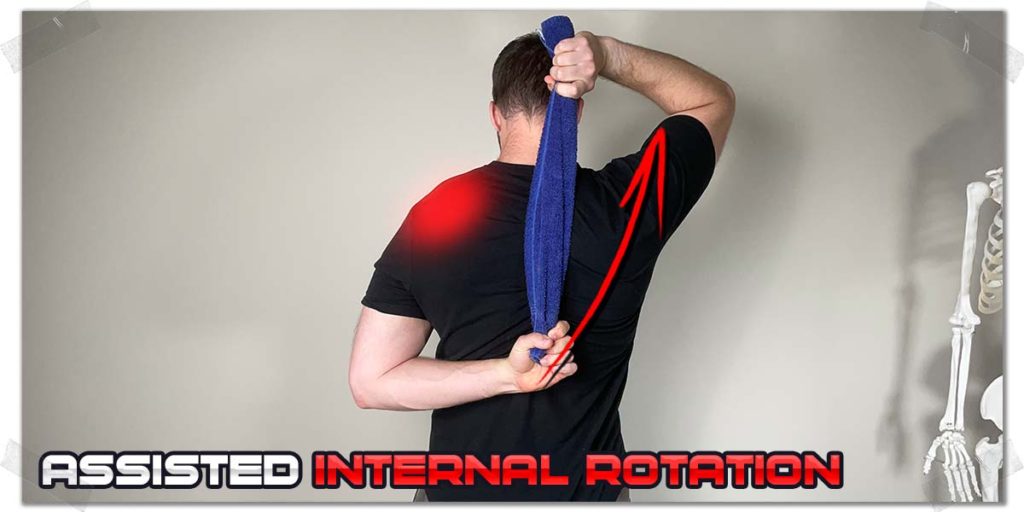
Thankfully, depending on the overall stage and severity, a frozen shoulder is most often a self-limiting condition, meaning the affected individual can safely perform movements and activities to whatever extent they can physically tolerate.2
With that being said, there is a fair amount of information to unpack regarding what your shoulder will tolerate when attempting to remain physically active. As such, there are a few things we need to consider and keep in mind (which I’ll go over shortly).
Whether you’re looking to perform specific therapeutic exercises to help reduce pain and restore mobility, or you want to keep your physical exercise regimen as uninterrupted as possible, the remainder of this article will walk you through a very generalized regimen for moving your shoulder in ways that should be therapeutic for reducing discomfort and restoring shoulder mobility.
The types of movements, exercises, and stretches that you can perform with a frozen shoulder vary greatly depending on different factors, such as how painful or restrictive your frozen shoulder is, the stage of your frozen shoulder, and whether any other underlying factors (arthritis, rotator cuff tendinopathy, etc.,) are currently affecting the shoulder as well.
The information that follows assumes a few conditions:
- The only issue affecting the shoulder joint is the shoulder capsule itself, meaning there aren’t other issues simultaneously occurring that might be contributing to your pain or dysfunction (such as a rotator cuff tear, subacromial bursitis, etc.).
- That the overall severity of the frozen shoulder is only mild or moderate at most (if it is severely painful or has lost significant mobility, a different approach may be required).
- You only have stiffness and generalized discomfort around the shoulder joint region and no additional symptoms in your shoulder or arm (such as numbness or tingling).
Even if you don’t plan on doing your best to carry on with workouts or physical activities, most individuals must implement a daily stretching and mobility routine for their shoulder capsule, assuming they want to regain as much movement as possible and do so in the shortest timeframe possible.
Active-assisted and passive stretches
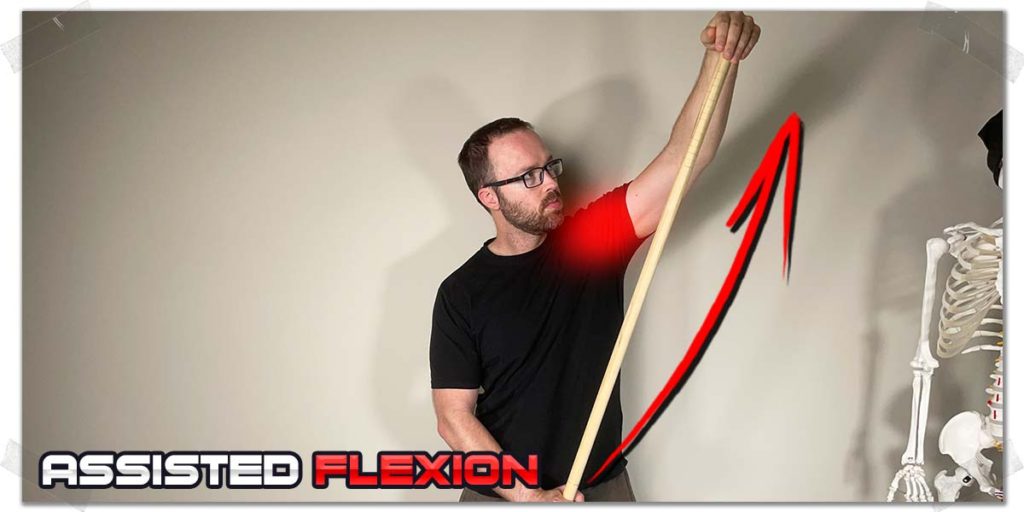
An “active” movement refers to a movement that is produced by using your muscles. An “active-assisted” movement refers to a movement that is performed as much as possible with your muscles but also with external assistance. This assistance can be from another person (such as a therapist) or from using an external object, such as a set of pulleys or a dowel (discussed below).
Passive movements are those where a joint within the body is moved without any use or activation of your muscles. These too can be performed either by another individual or by using equipment.
Both active-assisted and passive movements can be very helpful for maintaining or regaining shoulder mobility while minimizing pain and discomfort in the process.
As such, it would likely be wise to begin implementing active-assisted and passive shoulder movements into your daily routine, in addition to performing any active shoulder movements you do as part of your workouts or exercise sessions.
Below are some standard passive and active-assisted movements that you can try to work on your shoulder mobility while keeping pain or unnecessary discomfort to a minimum.
Arm circles and pendulums
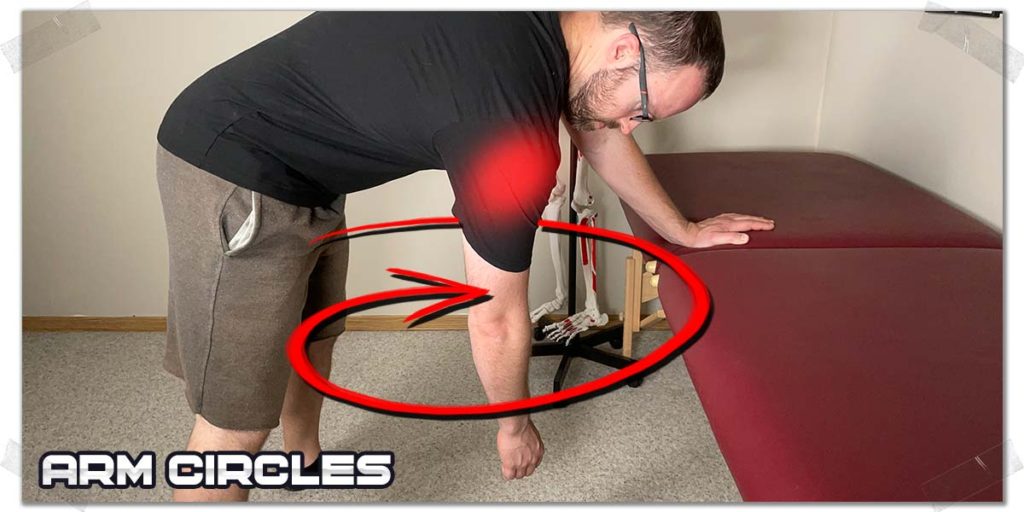
Arm circles and pendulums can be an ideal exercise for those dealing with a frozen shoulder that’s quite painful (which is typically in the freezing stage). The goal here is to produce multidirectional shoulder joint movement while not using any of your shoulder muscles in the process.
Here’s how to do them:
- Rest your non-affected arm on a surface such as a countertop.
- Bend forward slightly while letting your affected shoulder and arm hang beneath you.
- For arm circles: Stir your body in a circle (not your arm itself) to generate a gentle passive circular movement at the shoulder joint. This should produce movement that is pain-free or minimal discomfort at most.
- For pendulums: Assume the same starting position but swing your body side to side, or forwards and backwards, rather than in a circular motion. Your arm will begin to swing like the pendulum on a clock.
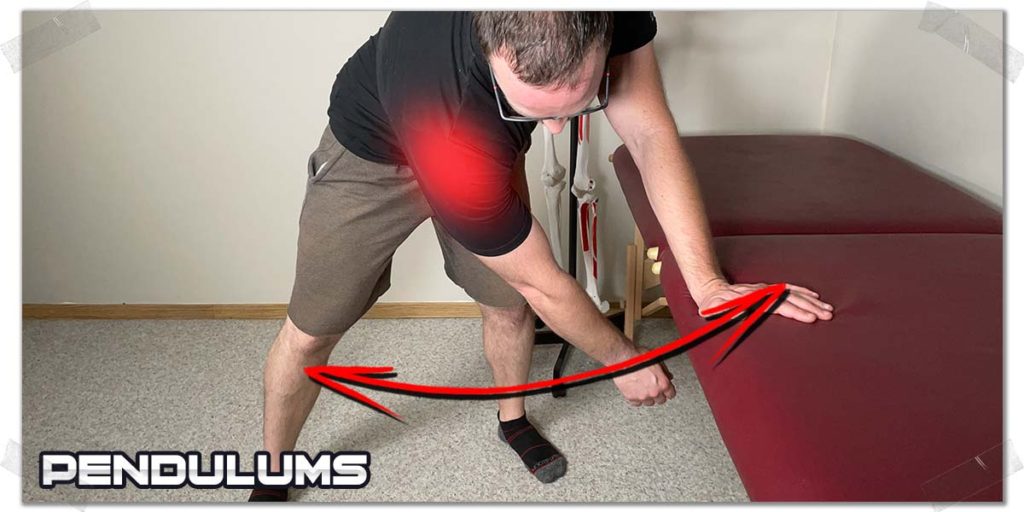
While the frequency and amount of performing these exercises will vary based on an individual’s needs and abilities, most individuals can benefit from performing each of these exercises a couple of times per day, with one or two minutes spent performing each movement.
Dowels & pulleys
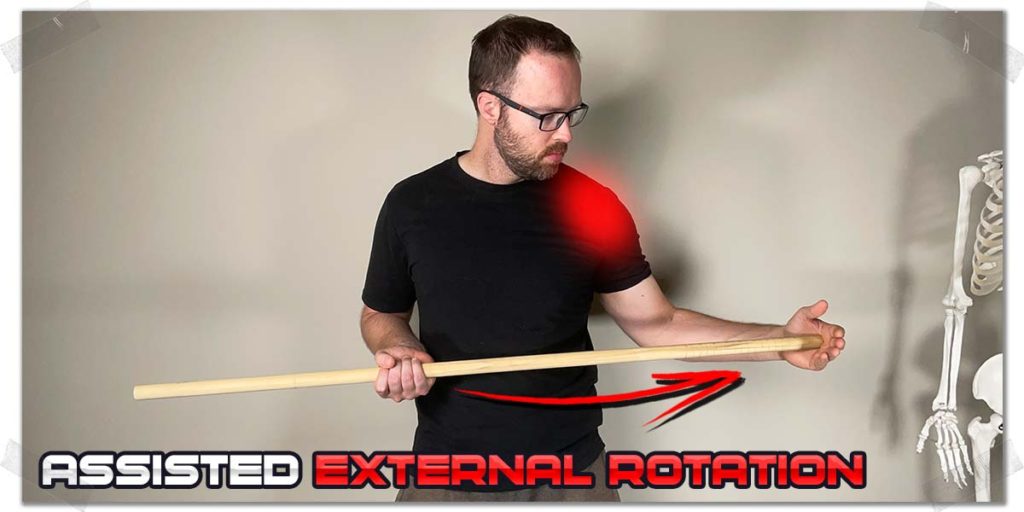
Two invaluable pieces of equipment for performing passive range of motion exercises for a frozen shoulder are a dowel and a set of pulleys. Each piece of equipment can help you stretch your shoulder and challenge its capsular mobility in healthy ways.
Since a dowel or set of pulleys allows you to perform shoulder movement without using the shoulder muscles, they permit you to stretch the shoulder capsule to a greater extent and for a longer period of time, making them valuable tools in the battle against frozen shoulder.
Pro tip: Using a heating pad on your shoulder for upwards of twenty minutes can help to relieve discomfort and relax tissues around the shoulder. If you can heat your shoulder right before a movement or stretching session, you may find that it helps reduce shoulder discomfort and improve your range of motion with your movements and stretches. Evidence shows that those who heat their shoulder before performing a stretching protocol for their shoulder experience better results than those who don’t.5
Personally, if I could only use one of these two implements, it would be pulleys; they take less effort, and it’s easier to hold stretches for longer periods of time than when using a dowel (but a dowel is still great to use, mind you).
For a good pulley routine:
- Set your pulleys up on the top of a door, then sit in a chair with your back to the door.
- Using your non-affected shoulder, pull downwards on the pulley so that your affected arm and shoulder passively raise up in the air.
- Go as high as you comfortably can. Hold the end position for a couple of seconds, then slowly lower your affected arm and shoulder back to the starting position.
- Perform these slow repetitions for ten to twenty minutes, ideally a couple of times per day (so long as your pain or overall shoulder condition isn’t worsening in the process).
For a good dowel routine:
A dowel makes for a great alternative or supplement to a pulley routine, especially when pulleys aren’t available or practical. What’s even better, you can use everyday home items to perform the following movements, such as a broom handle, a golf club, a hockey stick, etc. Just find what works for you.
Simply place the hand of your affected shoulder on top of the end of the dowel/stick. Then use your non-affected arm to push your affected arm up into the air, going as high as you can until you experience mild discomfort (just like with the pulleys). Hold this position for a few seconds, then slowly lower your am back down and repeat.
Do this movement going straight forwards and at a 45-degree angle out to the side.
You can also opt for doing external rotations, which is another great movement for your shoulder capsule. Simply bend your elbows to 90 degrees and use your non-affected arm to push your affected arm outwards so that it rotates away from your body.
Again, as long as none of these exercises are painful or making your shoulder feel worse, it’s likely a good idea to get into the habit of performing these dowel exercises a couple of times per day, with one or two minutes given for each movement.
Staying active: Working out & exercising
When dealing with a frozen shoulder, staying as physically active as possible is, of course, a good idea (remember, it tends to be a self-limiting condition); however, the activity or activities must be appropriate based on your own current needs and condition. An exercise or movement that is perfectly tolerated by one frozen shoulder might not be tolerated in the slightest by another.
Therefore, remember that it’s best to adhere to general principles while acknowledging that there will likely need to be a bit of trial and error to determine what your shoulder can tolerate.
General modifications to your workouts and exercises can include:
- Reducing the intensity of your exercises or regimen
- Performing different exercises to avoid pain or discomfort
- Modifying the speed, resistance and range of motion of your exercises
In addition to any workouts or general exercising you may be able to do, it is critical that you follow a dedicated and consistent movement and stretching routine for the shoulder joint itself.
Pro tip: Whether it’s a frozen shoulder or a sprained ankle, the life of a physically active individual is often filled with periods in which their workouts and exercises need to be modified to one extent or another. Don’t be afraid to modify your exercises or regimen as needed until you’re over your frozen shoulder. This is something we all have to do!
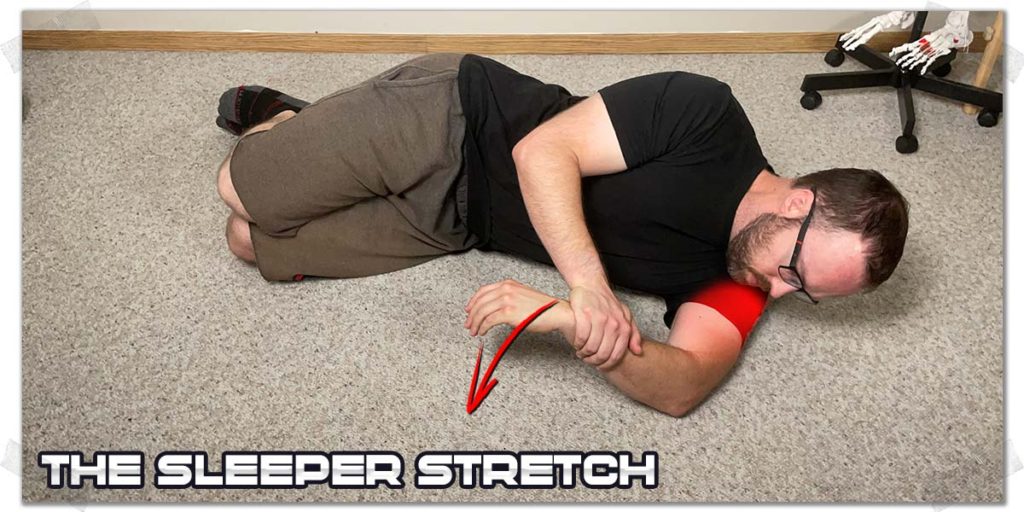
While it’s likely not reasonable to expect your shoulder to be entirely pain-free when performing daily movements or exercises within the gym, certain types of pain and amounts of pain should be considered off limits. This is the case whether you’re performing therapeutic exercises aimed explicitly at the capsule itself or with fitness-based exercises for home workouts, gym workouts, etc.
This is where the waters can become somewhat muddied based on the lack of general consensus on how to best treat and deal with a frozen shoulder; some experts advocate for playing it safe and drumming up minimal amounts of discomfort, while others advocate essentially beating the snot out of the capsule regardless of how painful the process may be.
As this is a generalized article that is not intended to be specific advice for your particular situation, I will be laying out a somewhat conservative approach. I may not treat every individual patient whom I treat with these same guidelines, but that’s because I’ve assessed their shoulder and their overall condition – something I haven’t done with you.
What follows are general guidelines and considerations for various forms of physical activities and workouts.
General warmups before exercise
If you’re looking to warm up your body before getting into the “meat and potatoes” of your workout, you don’t really need to overthink how to do so; any warmup movements, activities or stretches that don’t worsen your shoulder pain in the process are likely just fine to perform.
Pro tip: An effective pre-workout warmup routine that gets you to break a light sweat will elevate your body’s core temperature slightly while improving circulation. This can help reduce discomfort to your shoulder and help it be a bit more tolerant to your exercises.
Shoulder-specific warmups
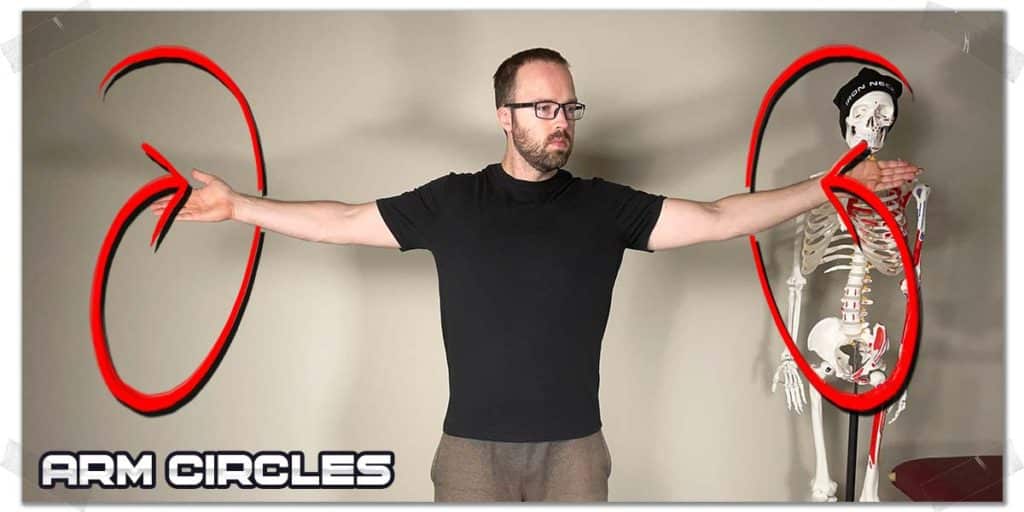
If you don’t want to perform a general, full-body warmup, it’s still a good idea to perform a shoulder-specific warmup before hopping right into your workout. You can also opt to perform one after a general warmup as well (which is what I would personally advocate).
Some shoulder-specific warmup movements you could try might be:
- Arm circles (forwards and backwards).
- General resistance band exercises.
- The sleeper stretch (a stretch that specifically targets the shoulder capsule).
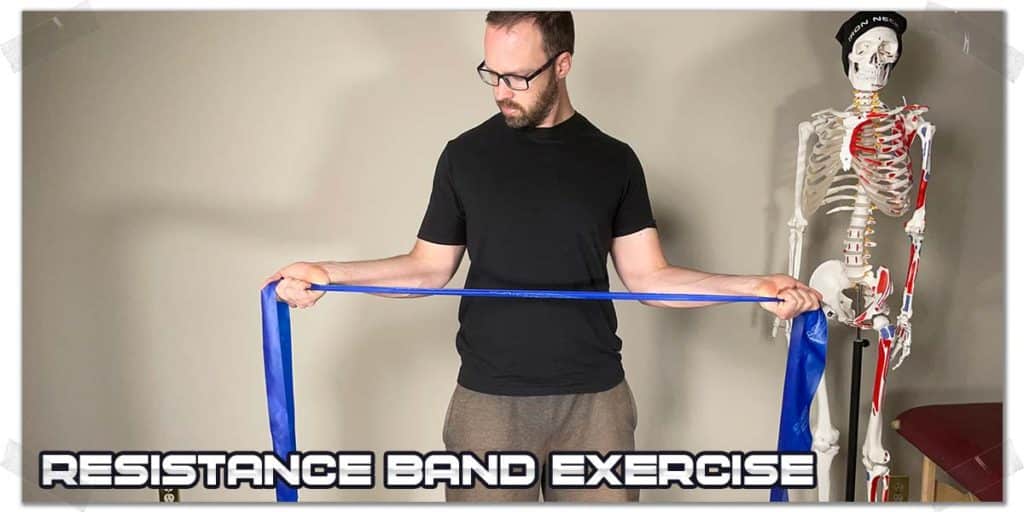
Performing cardio exercise
Performing cardio exercise while working through a frozen shoulder shouldn’t be terribly difficult, relatively speaking. I currently have a handful of patients on my caseload with rather advanced frozen shoulders who can still perform cardio exercise with little to no modifications.
As long as you’re self-limiting your cardio activities or intensity to within a pain-free experience, you will likely have various cardio modes to choose from. You might have to be mindful of forms of cardio that make heavy or moderate use of your shoulder, such as:
- Arm cycle ergometers
- Elliptical machines
- Rowing machines
- Assault bikes
- Versa climbers
When it comes to jogging or running, you’ll need to be mindful of how much arm movement or swinging you use. Listen to your body here; if it doesn’t feel good, forego it for the time being.
Related article: Shoulder Pain from the Elliptical Machine: Causes, Fixes and More
Performing strength training exercises
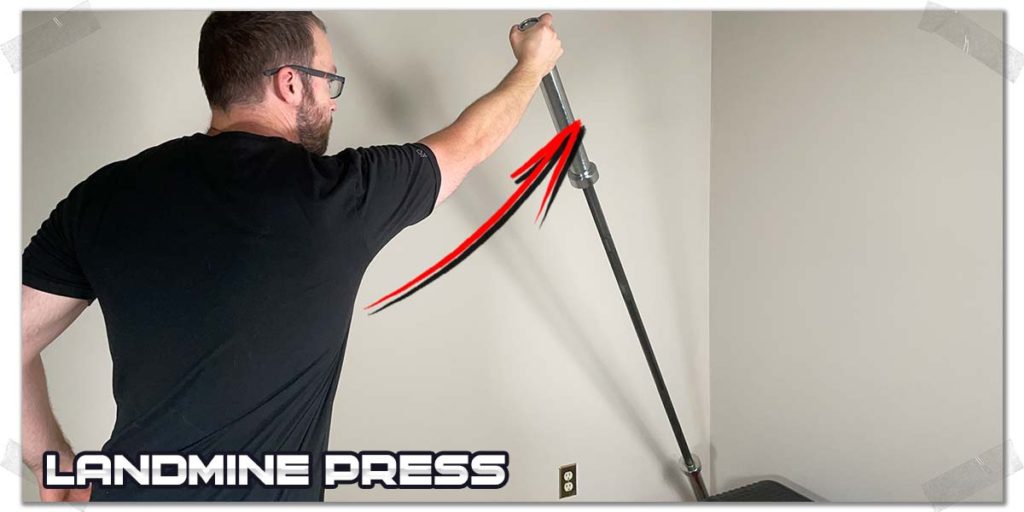
The same principles are at play for performing strength training exercises as mentioned above; as long as an exercise or movement isn’t causing pain, you’ll likely be just fine. It’s not realistic to think that your shoulder won’t feel some occasional or intermittent discomfort when doing some exercises, but discomfort is not the same as pain.
Mild discomfort when performing specific exercises may signify that you’re challenging the mobility of the shoulder capsule to an appropriate extent. Still, again, this is under the assumption that all the other structures of your shoulder are healthy and are not responsible for any discomfort you’re otherwise feeling.
Pro tip: If you have a rather typical presentation of frozen shoulder when it comes to a range of motion restriction, you’ll likely have a difficult time with overhead movements, such as shoulder pressing exercises of any variety.
If so, try opting for landmine presses. The landmine press is an outstanding shoulder and tricep exercise that requires less overhead range of motion than traditional shoulder presses but is still just as challenging and beneficial!
Related article: Strengthening Your Infraspinatus with a Dumbbell: (3 Proven Exercises)
Here are a couple of quick pointers:
- Lower body exercises/training are perfectly acceptable, so long as there’s no associated shoulder movement or positioning that produces high levels of pain for your shoulder, such as with kettlebell swings or barbell back squats (the latter might force your shoulder into an uncomfortable position when grabbing the bar).
- Upper body exercises that require no shoulder movement are likely perfectly acceptable as well. Such examples would be arm exercises such as bicep curls and tricep rope pulldowns. These types of exercises shouldn’t produce any perceptible shoulder discomfort since the shoulder does not move with exercises such as these.
- Upper body exercises that challenge your shoulder’s range of motion (without being painful) may be quite beneficial, as they can help to mobilize the joint capsule while strengthening the surrounding muscles.
- Performing upper body movements in a slow and controlled fashion is probably what’s in your best interest. Fast movements can cause unnecessary amounts of shoulder pain, which can set you back in your overall recovery and limit your ability to train your upper body as a result.
Final thoughts
A frozen shoulder can feel like an overwhelming battle to get through, but armed with the right information and staying as physically active as possible, you’ll get through it — I see it all the time with my patients.
Best of all, when you implement the right exercise parameters for staying physically active and using your shoulder in appropriate ways, you’ll very likely get over this condition at a much quicker rate (and to a much more complete extent) than if you don’t remain physically active.
I’m looking forward to hearing your comeback story!
References:
1. Le HV, Lee SJ, Nazarian A, Rodriguez EK. Adhesive capsulitis of the shoulder: review of pathophysiology and current clinical treatments. Shoulder Elb. 2017;9(2):75-84.
3. Ryan V, Brown H, Minns Lowe CJ, Lewis JS. The pathophysiology associated with primary (idiopathic) frozen shoulder: A systematic review. BMC Musculoskelet Disord. 2016;17(1):1-21.
4. Kelley MJ, Mcclure PW, Leggin BG. Frozen shoulder: evidence and a proposed model guiding rehabilitation. J Orthop Sports Phys Ther. 2009;39(2):135-148.

Hi! I’m Jim Wittstrom, PT, DPT, CSCS, Pn1.
I am a physical therapist who is passionate about all things pertaining to strength & conditioning, human movement, injury prevention and rehabilitation. I created StrengthResurgence.com in order to help others become stronger and healthier. I also love helping aspiring students and therapists fulfill their dreams of becoming successful in school and within their clinical PT practice. Thanks for checking out my site!

